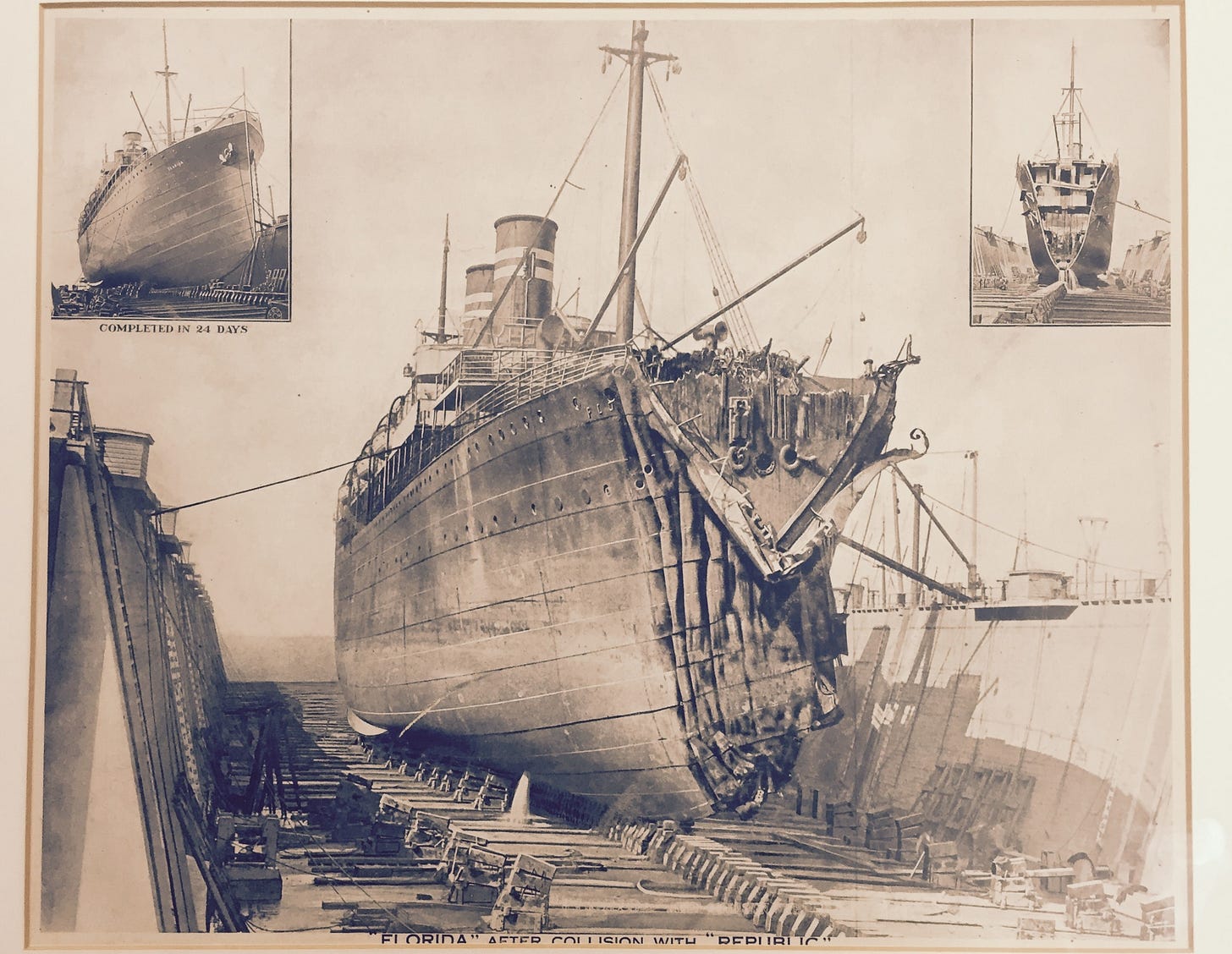A suspected murderer aboard the Lusitania defended by Conan Doyle Pt. 2
Mischief on the ocean liners Pt. 6
In this week’s video supplement, Char and I discuss the Lusitania’s maiden voyage, the origin of brownies, travel mishaps, and the transatlantic journey of three witnesses to the murder of Marion Gilchrist. -SZB
Note: in this video, we incorrectly identify the ship that sank as the Columbia rather than the Republic as described below.
On January 23, 1909, the White Star Line liner RMS Republic, sailing in an intense fog, was rammed by the Italian ship SS Florida off of the Northeastern coast of the United States. Despite having damage to its wireless set, the Republic was able to send out a distress signal, which was picked up by the White Star line Baltic ocean liner. Some passengers of the Republic were evacuated onto the less damaged Florida while others were evacuated onto the Baltic once it was able to locate the Republic in the fog through the use of rockets and bombs. At 8 o’clock in the evening the Republic sank. Only five lives were lost in the crash. This was one of the first incidents in which wireless technology was used to send out the distress signal CQD and save lives in an ocean liner disaster. The wireless technology also played an important role in providing news on the sinking and rescue to those onshore.

The Baltic arrived on to New York to the cheers of a large crowd. Aboard the Baltic, prior to the transfer of passengers from the Republic, was a group of investigators and witnesses from Glasgow, Scotland, involved in the recent murder of the wealthy elderly woman named Marion Gilchrist.
On December 21st, 1908, Gilchrist sent her servant Helen Lambie to get the evening newspaper. While she was out Gilchrist was attacked in her flat and had alerted her downstairs neighbor Mr. Adams after she knocked on the ground, their agreed upon signal of danger stemming from Gilchrist’s belief that she would be robbed. Arthur Adams joined Lambie upon her return and as the two entered the flat a man came out of the bedroom, passed behind them and ran downstairs. Gilchrist was found brutally murdered in the dining room.
A fourteen year old girl named Mary Barrowman had been passing the house on the night of the murder and was almost knocked down as the man ran out of the house.
Both Lambie and Adams described the man as “aged between twenty-five and thirty, five feet eight or nine inches tall, slim, dark-haired, clean-shaven, and wearing a light grey overcoat and a cloth cap.”1 However, the description that was provided of the suspect by Barrowman differed.
The small party from Glasgow sailing on the Baltic, which had departed from Liverpool on January 13th to New York, included William Warnock, chief Sheriff criminal officer, Detective Inspector Pyper, Arthur Adams, Helen Lambie, and Mary Barrowman.
The two female witnesses were allowed to see Slater prior to being asked to identify him in a group. This proved to be an unscrupulous decision made by Detective Pyper. While both of them identified Slater as the suspect after being able to see him prior, Arthur Adams refused to identify him due to what he stated was his short-sightedness. Despite the muddied process of his identification by the two female witnesses and the refusal to identify him by Mr. Adams, the police decided to proceed with charging Slater in the murder of Gilchrist.
For the Glasgow police, Slater was the perfect suspect due to his otherness as an immigrant as well as his background of gambling and alleged involvement in prostitution. At the time in Scotland there was much distrust toward immigrants due to the increase in population resulting from industrialization. Facts did not matter too much to this police force who felt they had found the righteous placement of the wrath of Glasgow’s community terrified by the shocking murder of a helpless elderly woman. Slater had been strongly advised to resist extradition to Scotland but decided to allow them to take him back as he believed the evidence would show his innocence.
In Part 3 of A suspected murderer aboard the Lusitania defended by Conan Doyle, we will discuss the trial of Oscar Slater for the charge of the murder of Marion Gilchrist.
https://www.policemuseum.org.uk/crime-casebook/interesting-cases/murder-of-marion-gilchrist-1908/
Sources:
https://www.arthur-conan-doyle.com/index.php/The_Case_of_Oscar_Slater
https://www.policemuseum.org.uk/crime-casebook/interesting-cases/murder-of-marion-gilchrist-1908/
“Extradition? Slater’s Changes at the New York Court, Witnesses’ Trying Ordeal” The Daily Record, Glasgow, Scotland, January 26, 1909, p. 5.
Fox, M., & Forbes, P. (2018). Conan Doyle for the Defense: The True Story of a Sensational British Murder, a Quest for Justice, and the World's Most Famous Detective Writer. Random House Audio.







I want to follow up with Mary Barrowman. Can't believe she traveled overseas as a witness at age 14.
I’m with Sarah! Who sent that child on an ocean voyage!
Again I love the video!
Part two is just a perfect cliff hanger Charlotte lol.
Isn’t amazing how much remains the same despite the years that pass.. ie the need for immigrants as employers vs their reception into the general populace of the country they immigrate to.
The country does truly need these people to settle in and gainfully work and yet there is the local crowd that never will accept “outsiders” no matter what. Even if the immigrants are enriching the country it matters not to hateful people.
It’s maddening to me that, that stupidity is still ongoing today.
I can’t wait for next week’s read!